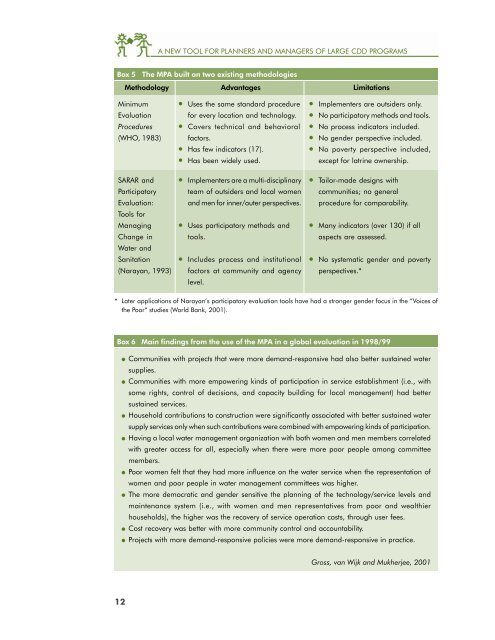Sustainability Planning and Monitoring
Sustainability Planning and Monitoring
Sustainability Planning and Monitoring
- No tags were found...
Create successful ePaper yourself
Turn your PDF publications into a flip-book with our unique Google optimized e-Paper software.
A NEW TOOL FOR PLANNERS AND MANAGERS OF LARGE CDD PROGRAMSBox 5 The MPA built on two existing methodologiesMethodology Advantages LimitationsMinimumEvaluationProcedures(WHO, 1983)●●Uses the same st<strong>and</strong>ard procedurefor every location <strong>and</strong> technology.Covers technical <strong>and</strong> behavioralfactors.● Has few indicators (17).●Has been widely used.●●●●●Implementers are outsiders only.No participatory methods <strong>and</strong> tools.No process indicators included.No gender perspective included.No poverty perspective included,except for latrine ownership.SARAR <strong>and</strong>ParticipatoryEvaluation:Tools forManagingChange inWater <strong>and</strong>Sanitation(Narayan, 1993)●●●Implementers are a multi-disciplinaryteam of outsiders <strong>and</strong> local women<strong>and</strong> men for inner/outer perspectives.Uses participatory methods <strong>and</strong>tools.Includes process <strong>and</strong> institutionalfactors at community <strong>and</strong> agencylevel.●●●Tailor-made designs withcommunities; no generalprocedure for comparability.Many indicators (over 130) if allaspects are assessed.No systematic gender <strong>and</strong> povertyperspectives.** Later applications of Narayan’s participatory evaluation tools have had a stronger gender focus in the “Voices ofthe Poor“ studies (World Bank, 2001).Box 6 Main findings from the use of the MPA in a global evaluation in 1998/99● Communities with projects that were more dem<strong>and</strong>-responsive had also better sustained watersupplies.● Communities with more empowering kinds of participation in service establishment (i.e., withsome rights, control of decisions, <strong>and</strong> capacity building for local management) had bettersustained services.● Household contributions to construction were significantly associated with better sustained watersupply services only when such contributions were combined with empowering kinds of participation.● Having a local water management organization with both women <strong>and</strong> men members correlatedwith greater access for all, especially when there were more poor people among committeemembers.● Poor women felt that they had more influence on the water service when the representation ofwomen <strong>and</strong> poor people in water management committees was higher.● The more democratic <strong>and</strong> gender sensitive the planning of the technology/service levels <strong>and</strong>maintenance system (i.e., with women <strong>and</strong> men representatives from poor <strong>and</strong> wealthierhouseholds), the higher was the recovery of service operation costs, through user fees.● Cost recovery was better with more community control <strong>and</strong> accountability.● Projects with more dem<strong>and</strong>-responsive policies were more dem<strong>and</strong>-responsive in practice.Gross, van Wijk <strong>and</strong> Mukherjee, 200112
















